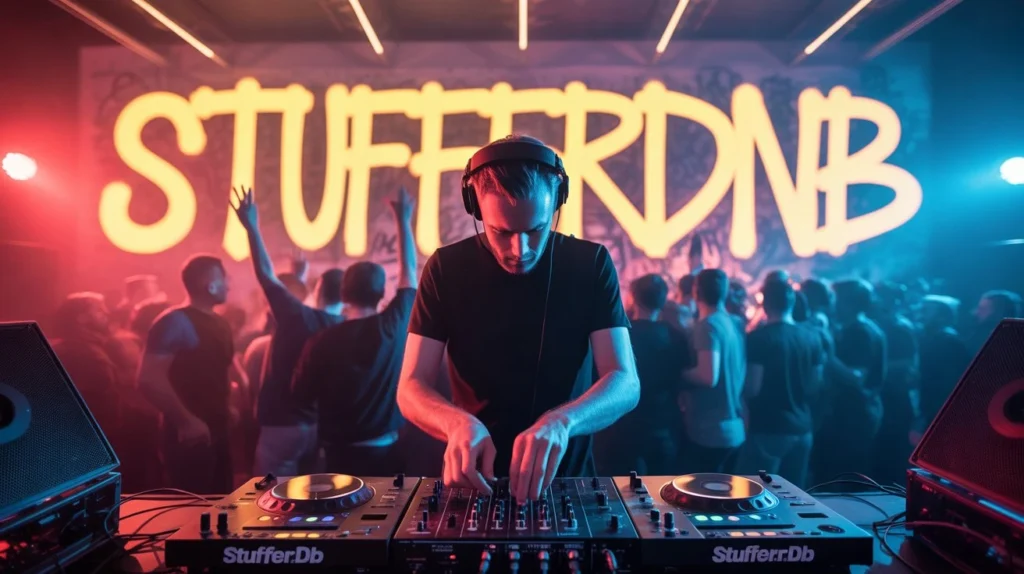Bass music has always lived in the shadowy corners of club culture, but every few years, something disrupts the silence and sends subwoofers into chaos. That’s what’s happening now with stufferdnb — a fast-evolving, often misunderstood, yet utterly electrifying subgenre of drum and bass that’s captivating underground ears across continents.
But why all the sudden attention? And why should any bass music fan, artist, or promoter care about this niche? Let’s unpack the noise, understand the pulse, and dive headfirst into what makes stufferdnb more than just another internet-born genre tag.
What is StufferDNB
Stufferdnb, for those unfamiliar with the term, refers to a stylistic blend within the drum and bass universe, often recognized for its chaotic structure, distorted layers, glitchy elements, and unconventional rhythm transitions. Emerging as a fringe soundscape on platforms like SoundCloud and Bandcamp, stufferdnb combines experimental design with raw energy, carving out a home where traditional rules of composition simply don’t apply.
Unlike liquid DnB or neurofunk, which follow more structured rhythmic patterns and sonic textures, stufferdnb thrives on tension, disruption, and unpredictability. It’s deliberately jarring — that’s the point. It stuffs layers of noise, breaks, and warped basslines into moments that feel simultaneously wrong and right.
The Birthplace of Sonic Chaos
The early experiments of stufferdnb can be traced to lo-fi production bedrooms and underground clubs in Eastern Europe and the UK, where young producers rejected polished sound for something more anarchic. Producers like Sys-X, Hexphase, and BrokeKernel began uploading early mixes that challenged what DnB fans thought was even listenable.
Through digital communities, particularly Discord servers and niche DnB collectives, the sound spread quickly. The name “stuffer” came as a joke — referring to how producers would literally stuff multiple rhythms and effects into single bars, ignoring traditional timing, BPM stability, and EQ balance.
Yet, within that chaos, something magnetic happened. It was art — abrasive, intense, and strangely addictive.
Why StufferDNB is Gaining Serious Momentum
The resurgence of underground and DIY music scenes after the pandemic brought a wave of interest in raw, unfiltered audio. Gen Z especially seeks sounds that aren’t sanitized by algorithms or polished to fit commercial playlists. Stufferdnb offered a rebellion. It doesn’t ask for permission — it demands attention.
Social platforms like TikTok and Instagram Reels began to feature edits backed by glitchy stufferdnb drops, while alternative festivals from Berlin to Melbourne started to book sets exclusively dedicated to this sub-style.
And as the popularity grew, so did the sophistication. Producers began integrating elements from jungle, techno, footwork, and even IDM, turning stufferdnb into a more nuanced, albeit still chaotic, movement.
Listening to StufferDNB is a Full-Body Experience
You don’t just hear stufferdnb. You feel it. The sheer unpredictability means you can’t relax into a groove — and that’s the point. Your body reacts viscerally. Dancers find themselves moving erratically, responding to strange beat drops and off-time fills that challenge rhythm memory.
It’s almost theatrical. The audience becomes part of a sound experiment, unsure where the next sonic jab will hit.
At events like Signal Burst in London or Frakture in Prague, stufferdnb sets are intentionally scheduled at peak hours to jolt energy through crowds. The room gets transformed into a vortex of syncopated chaos — and people love it.
How Artists Are Shaping the Sound
The producers shaping the stufferdnb scene today aren’t chart-toppers — they’re sound rebels. Working with limited tools but limitless creativity, these artists often design their own virtual instruments, repurpose analog gear, or layer unexpected samples like field recordings, broken MIDI data, and VHS static.
Artists like ZedNull, AetherPitch, and MuteSyntax have pushed boundaries with releases that blur lines between musical composition and digital collage. Many avoid labels entirely, instead distributing through underground collectives or self-releasing via cryptic Bandcamp pages.
These aren’t just musicians. They’re architects of noise.
Production Techniques Behind the Madness
Crafting a stufferdnb track isn’t for the faint-hearted. It requires both an understanding of sound design and a willingness to break every rule in the book. Here’s a peek into how some producers build their chaotic symphonies:
They begin with breakbeats — often distorted, sometimes reversed. Next comes the layering: metallic percussive loops, glitchy vocal samples, and wide stereo pads cut by razor-sharp bass stabs.
Producers may automate BPM changes mid-track, intentionally detuning elements to create discomfort, or stack multiple snare patterns that intentionally clash. It’s less about “flow” and more about the impact of disruption.
Challenges and Criticisms Around StufferDNB
Of course, with any disruptive genre comes controversy. Some call it “noise with no purpose,” criticizing it for being deliberately inaccessible. Others argue that it lacks emotional resonance or overuses digital distortion.
There’s also a concern about saturation — as more amateur producers try their hand at stufferdnb, the line between artistic chaos and plain bad mixing becomes blurry.
But here’s the truth: stufferdnb isn’t supposed to be comfortable. It’s designed to disrupt. And in that disruption lies its beauty.
StufferDNB in the Global Club Circuit
While still a niche, stufferdnb has started appearing on festival flyers, underground club posters, and curated online events across Europe, Asia, and North America. Collectives like NoiseForm in Tokyo and Basement Algorithms in New York have championed the sound, offering platforms for new artists and live performers to push boundaries even further.
Interestingly, some techno and experimental ambient producers have begun collaborating with stufferdnb artists, creating hybrid sets that move between tension and release.
Audience Reactions and Cultural Shifts
Audience reception varies wildly. First-time listeners are often confused, sometimes overwhelmed. But something changes after that initial shock. They come back. They crave it. The music taps into a cultural undercurrent — one that rejects perfection and embraces raw expression.
For younger listeners who’ve grown up with hyper-edited content and algorithm-curated playlists, stufferdnb feels like rebellion. It’s unpredictable, it’s raw, and it has no desire to conform.
My Experience Navigating the StufferDNB Scene
As someone who’s attended over a dozen underground shows and interviewed multiple artists within the scene, I can tell you — there’s no sound quite like this. The first time I heard a live stufferdnb set was in a converted warehouse in Rotterdam. No lights. Just strobes and noise. It felt like standing inside a collapsing digital cathedral.
And yet, when the crowd screamed at a particularly absurd drop, I understood: this wasn’t just music. It was catharsis. It was release.
StufferDNB Is a Statement, Not a Genre
This style isn’t just about sound — it’s a social and artistic statement. It challenges the mainstream, disrupts predictability, and invites listeners to engage differently.
In a world that often values polish over passion, stufferdnb offers something real — even if it’s uncomfortable.
What the Future Holds for StufferDNB
While it’s still early days for stufferdnb as a defined genre, its influence is already leaking into other styles. Expect to see more cross-genre collabs, label samplers with stuffer elements, and experimental artists blending techniques into wider projects.
Music schools and production bootcamps have even begun adding sections on “disruptive layering” and “controlled chaos” — concepts heavily inspired by this sound.
StufferDNB in 2025: Why It Matters Now
Why should anyone pay attention now? Because stufferdnb is more than a fringe audio experiment. It’s part of a bigger conversation about music’s role in cultural identity, digital fatigue, and creative authenticity.
As AI-generated songs flood platforms and major labels polish every second of audio, this genre feels human again — flawed, emotional, intense. It’s the sound of rebellion. And it’s not going away.
FAQs
What makes stufferdnb different from regular drum and bass?
Stufferdnb uses chaotic, layered sound design with unpredictable rhythms, unlike regular DnB which often relies on structured beats and fluid progression.
Is stufferdnb considered mainstream?
Not yet. It remains an underground movement but is gaining popularity in niche club scenes and digital music circles.
Can beginners produce stufferdnb?
Yes, but it requires a solid understanding of sound layering, distortion control, and creative risk-taking. It’s not ideal for producers seeking easy formulas.
Why is it called stufferdnb?
The term originated as a joke about overstuffing tracks with layers and samples, but it stuck due to its descriptive accuracy.
Where can I listen to stufferdnb tracks?
Platforms like SoundCloud and Bandcamp host most of the genre’s content, especially through underground collectives and DIY artist pages.
Is stufferdnb only electronic music?
Primarily yes, though it’s starting to influence hybrid genres and collaborate with live instrumentations in some experimental spaces.
Final Thoughts on StufferDNB
Stufferdnb may not be easy to digest, but that’s exactly its strength. It pushes boundaries, ignites conversations, and reclaims music as an emotional, chaotic, human experience. If you’re willing to open your ears to a little madness, there’s a world waiting for you inside the stufferdnb scene.






